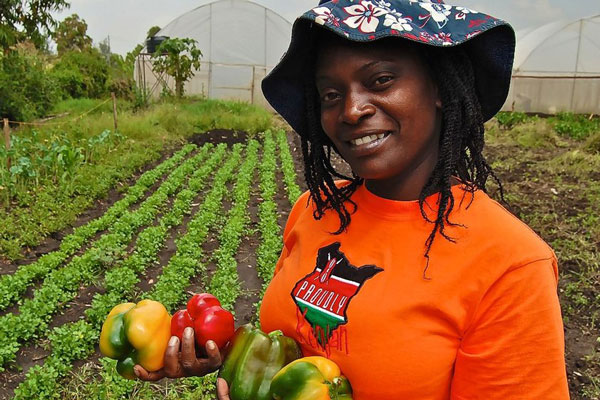
For subsistence farmer Sinikiwe Sibanda, planting more sorghum and millet than maize has paid off.
BY BUSANI BAFANA
As the coronavirus pandemic has led to decreased incomes and increased food prices across the southern African nation — it is estimated that more than eight million Zimbabweans will need food aid until the next harvest season in March — Sibanda’s utilisation of traditional and indigenous food resources could provide a solution to food security here.
Sibanda, a farmer in Nyamandlovu, 42km north-west of Bulawayo, harvested two tonnes of millet this year, compared to less than 700kg of maize.
Some farmers did not harvest maize at all, but those who planted sorghum and millet have enough food to last the next harvest season.
And Sibanda is pleased to have the harvest despite the poor rainfall in the 2018/9 farming season.
She is one of an increasing number of farmers from semi-arid areas with little rain who are shifting from growing white maize to hardy, traditional sorghum and millet for food and nutrition security.
“I love maize, but the frequent drought is making it difficult to grow it regularly,” Sibanda, told IPS during a visit to her 42-hectare farm in the semi-arid Matabeleland North province.
- Chamisa under fire over US$120K donation
- Mavhunga puts DeMbare into Chibuku quarterfinals
- Pension funds bet on Cabora Bassa oilfields
- Councils defy govt fire tender directive
Keep Reading
Sibanda said she now plants just five hectares of her farm.
She used to plant 10 hectares, but the high costs of seed, labour and uncertain rainfall each year has forced her to scale down.
“I learnt my lesson last season and planted one hectare under pearl millet, another under sorghum and a bigger portion under maize, but millet produced the best yield,” Sibanda, who has grown pearl millet and sorghum since 2015, said.
“Drought every year has reduced maize yields and many times I harvest nothing if I do not replant midway through the season,” she said.
“Maize needs more rain and easily wilts when we have poor rains as we did this year, but I am able to harvest something with small grains.”
Even livestock farmers are turning to sorghum. Livestock breeder Obert Chinhamo is intercropping sorghum and maize under rain-fed production at his Biano Farm, 30km south of Bulawayo.
He processes the sorghum and maize into silage for feeding his 300 pedigree Simmental cattle during the dry season when pastures become scarce and poor in nutrients.
Chinhamo is teaching farmers to make their own feed using rain-fed sorghum.
The shift to eating millet foods has not been an easy one for Sibanda’s family.
Zimbabwe is a maize-loving nation where maize flour is consumed at least thrice a day when it is available.
Though Sibanda said she savours millet flour, with which she makes tasty porridge and isitshwala (a carbohydrate staple food made from millet meal), her urbanised children do not enjoy it.
“It thickens quicker than maize flour, it tastes good and is healthy too,” chuckled Sibanda.
According to the Famine Early Warning Systems Network (FewsNet), “the deteriorating economy and consecutive droughts were already driving high food assistance needs; the Covid-19 pandemic and measures implemented to prevent the virus’ spread are further exacerbating an already deteriorating food security situation.
“Humanitarian assistance needs during the January to March 2021 peak of the lean season are expected to be above normal, with widespread areas in crisis.”
Food-insecure households here require assistance to supplement adequate dietary intake and prevent deterioration of the nutrition status of children, women and other vulnerable groups like the disabled, says the United Nations Office of the Coordination of Humanitarian Affairs in Zimbabwe.
According to the February 2020 Zimbabwe Vulnerability Assessment Committee rapid assessment, global acute malnutrition prevalence increased from the 3,6% to 3,7% at national level.
The drought-prone provinces of Masvingo and Matabeleland North and South were most affected.
Figures by the United Nations Children’s Fund (Unicef) showed that “nearly one in three children under five are suffering from malnutrition, while 93% of children between six months and two years of age are not consuming the minimum acceptable diet”.
Zimbabwe remains one of only 11 countries that have not implemented healthy eating guidelines at a national level, according to the Food Sustainability Index, created by Barilla Centre for Food and Nutrition (BCFN) and the Economist Intelligence Unit.
The increased production of sorghum and millets could aid food security and nutrition.
Small grains are the food for the future, said Hapson Mushoriwa, lead breeder for Eastern and Southern Africa at the International Crops Research Institute for Semi-Arid Tropics (Icrisat).
They are sustainable, nutritious and have a low carbon footprint, relative to maize, arising from carbon dioxide, methane and nitrous oxide emitted into the atmosphere during production, according to Mushoriwa.
Icrisat is developing adapted varieties of six key cereals and legumes, including sorghum, pearl millet, groundnuts and pigeon pea, among others.
Mushoriwa said these crops are bred to combine high productivity, resilience, acceptable quality attributes and market preferences.
“When you look at these six mandate crops, we label them as ‘Smart Food’ because they are good for you and highly nutritious, good for the planet (they have a low water footprint and lower the carbon footprint), good for the soils and use few chemicals,” Mushoriwa told IPS.
“These crops are good for the small-holder farmer because they survive in the hardest climates, have multiple uses, potential to significantly increase yield and untapped demand.”
Small grains are an integral part of agriculture biodiversity which the Food and Agriculture Organisation of the UN says supports the capacity of farmers to produce food and a range of other goods and services under different environments by increasing resilience to shocks and stresses.
The erosion of agro-biodiversity, combined with an emphasis on input-intensive cropping systems, has, arguably, lowered the resilience of food systems in the global South, said Katarzyna Dembska, a researcher at the BCFN Foundation, an independent and multi-disciplinary think-tank that analyses the economic, scientific, social and environmental factors about food.
Dembska said the utilisation of traditional and indigenous food resources in Africa, namely barley, millet, sorghum, millet cowpea and leafy vegetables, should be emphasised for achieving food security and nutrition.
“The under-utilised food resources have a much higher nutrient, and in times of high climate uncertainty, the diversification of staple crops can guarantee food system resilience,” Dembska told IPS. — IPS










